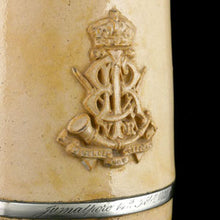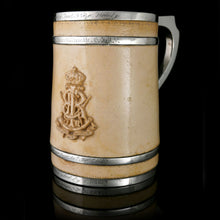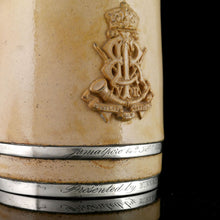East Indian Railway Volunteer Rifles Prize Tankard, 1880
- Regular price
- £545
- Sale price
- £545
- Regular price
-
- Unit price
- /per
Adding product to your cart
Height: 14.3cm (5.6in)
Silver banded stoneware pottery. A relic of the British contribution to Indian infrastructure. The body of silver handled tankard applied with the badge of the East Indian Railway Volunteer Rifle Corps to the front and the initials of the prize winner to the reverse. The rim and successive bands Inscribed: ‘Running Tiger Prize Won by / Sergt. Ignace Kotkowskie E.I.V.R. / Jumalpore 14th Febr 1880 / Presented by Burn & Co.’ Backstamp of Burn & Co. to the base.
Read more
Sgt. Ignace Kotkowski was a fitter working on the railway at Jamalpur (or Jumalpore), and was no doubt encouraged by his employer to give over a portion of his leisure hours to the East Indian Railway Volunteer Rifle Corps - an auxiliary unit formed in July 1869 as part of the British Indian Army's Bengal Command. It drew on civilian staff of the East Indian Railway and was headquartered at Jamalpur, where the East Indian Railway's locomotive workshops were located. The maker and donor of the prize was a conglomerate, Burn & Co, with origins dating back to 1809. The civil engineering arm was started in 1871 by Colonel Archibald Swinton. The company had its head office in Calcutta, a site in Howrah known as the Howrah Iron Works, and offices in Bombay, Raneegee, Jubblepore, Rangoon, Singapore and Straits Settlement. Its UK based company was Burn, Craddock & Co which had offices in London and Glasgow. Burn & Co. also owned large factories at Jubbulpore and several at Raneegunge which supplied tiles, bricks, stoneware, pipes and a brickworks at Durgapur. It built many public buildings and factories. It built the Calcutta Tramway system and most of Calcutta’s drainage system. The Howrah Iron Works became a major railway contactor from the very beginning of railways in India in the 1850’s. With the rapid expansion of Railways, Burn & Company started manufacturing Railway rolling stock at Howrah to cater to the increasing demand.

The East Indian Railway Rifle Volunteers at their camp of exercise, 1870,NAM
Ref: ‘Directory & Almanac for 1897’ - Alphabetical List of Europeans and East Indians in the East Indian Railway Company’s Service.










